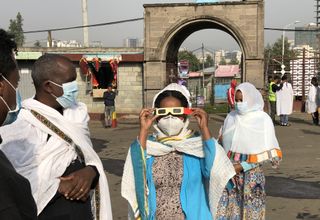'Ring of fire' solar eclipse of 2020 dazzles skywatchers across Africa and Asia
It's the only one of its kind this year!
The sun and moon converged in a dazzling "ring of fire" solar eclipse Sunday (June 21), stunning skywatchers across parts of Africa, Asia and more.
During the solar spectacle, known as an annular solar eclipse, the moon covered most — but not all — of the sun. During this type of eclipse, a bright "ring of fire" of the sun remains visible around the edge of the moon. The eclipse began at 11:45 p.m. EDT Saturday, June 20 (0345 GMT Sunday) and went until 5:34 a.m. EDT (1034 GMT) this morning.
The crown jewel of the event, the "ring of fire" section of the eclipse when the moon, sun and Earth lined up just so to create the brilliant effect (also known as maximum eclipse), occurred at around 2:40 am EDT (0640 GMT).
While not everyone around the world was able to view the event, it was visible either in its entirety or as a partial solar eclipse to potentially millions of spectators across the Democratic Republic of the Congo, Central African Republic, South Sudan, Sudan, Ethiopia, the Red Sea, Yemen, Saudi Arabia, Oman, the Gulf of Oman, Pakistan, India, China, Taiwan, the Philippine Sea (south of Guam) and northern Australia had a front-row seat for the stellar performance. Here's a look at some of the amazing views.
Related: Solar eclipse guide 2020: When, where & how to see them

Rare solare clipse thrills millions of Chinese observers. #SolarEclipse2020 https://t.co/MwWDJBbauU pic.twitter.com/YUTtP7A5yJJune 21, 2020

#SolarEclipse2020 from our house in New Delhi, India. pic.twitter.com/jmzFro7WHEJune 21, 2020
#SolarEclipse2020, thanks to .@Slooh! pic.twitter.com/1Nnie5E8WSJune 21, 2020

“Ring of fire” another view on solar eclipse. #SolarEclipse2020 #solareclipse pic.twitter.com/fSVzjhWk6gJune 21, 2020

The eclipse, crossing two continents and 14 total countries, covered a wide path but the path of greatest visibility was actually quite narrow, according to Time and Date. For example, in Uttrakhand, India at the location of Greatest Eclipse, the path is only about 13 miles (21 kilometers) wide and the "ring of fire" lasted for just about 38 seconds.
Unfortunately, especially with travel restrictions imposed during the COVID-19 pandemic, many people will not be able to witness the extravagant display in person. Luckily, a number of webcasts held live, online watch parties so that people could enjoy the event remotely.
Get the Space.com Newsletter
Breaking space news, the latest updates on rocket launches, skywatching events and more!
While most eclipse seasons typically have two eclipses — one lunar and one solar — this eclipse season actually has three. This solar eclipse was the second of that trio. The first, a lunar eclipse, came on June 5, and the final of the three, another lunar eclipse, will happen late on the night of July 4-5. These lunar eclipses are what are known as penumbral lunar eclipses. These types of eclipses are very slight and not as flashy as, say, the "ring of fire."
Amazing photos: Annular Solar Eclipse of May 20, 2012

The Dramatic “Ring of Fire” above Burj Khalifa. #SolarEclipse2020#solareclipse pic.twitter.com/gCzF0dN37KJune 21, 2020
Annular Solar Eclipse from Taiwan#NASA pic.twitter.com/jhi0QZczcuJune 21, 2020
Lunar eclipses happen when the moon moves into the way of Earth's shadow. With a penumbral lunar eclipse, only Earth's outer shadow moves in front of the moon, so it looks very similar to how it would look otherwise.
Later this year, in the next eclipse season which will span through November and December, there will be another penumbral lunar eclipse Nov. 30 and a total solar eclipse, visible from Chile and Argentina, on Dec. 14.
Editor's Note: If you capture a stunning photo of the solar eclipse and would like to share it with Space.com's readers, send your photos, comments, and your name and location to spacephotos@space.com.
- The 8 most famous solar eclipses in history
- Solar eclipses: An observer's guide (infographic)
- Eclipse season 2020 has arrived! Catch 2 lunar eclipses and a 'ring of fire' this summer
Email Chelsea Gohd at cgohd@space.com or follow her on Twitter @chelsea_gohd. Follow us on Twitter @Spacedotcom and on Facebook.
OFFER: Save 45% on 'All About Space' 'How it Works' and 'All About History'!
For a limited time, you can take out a digital subscription to any of our best-selling science magazines for just $2.38 per month, or 45% off the standard price for the first three months.
Join our Space Forums to keep talking space on the latest missions, night sky and more! And if you have a news tip, correction or comment, let us know at: community@space.com.

Chelsea “Foxanne” Gohd joined Space.com in 2018 and is now a Senior Writer, writing about everything from climate change to planetary science and human spaceflight in both articles and on-camera in videos. With a degree in Public Health and biological sciences, Chelsea has written and worked for institutions including the American Museum of Natural History, Scientific American, Discover Magazine Blog, Astronomy Magazine and Live Science. When not writing, editing or filming something space-y, Chelsea "Foxanne" Gohd is writing music and performing as Foxanne, even launching a song to space in 2021 with Inspiration4. You can follow her on Twitter @chelsea_gohd and @foxannemusic.

